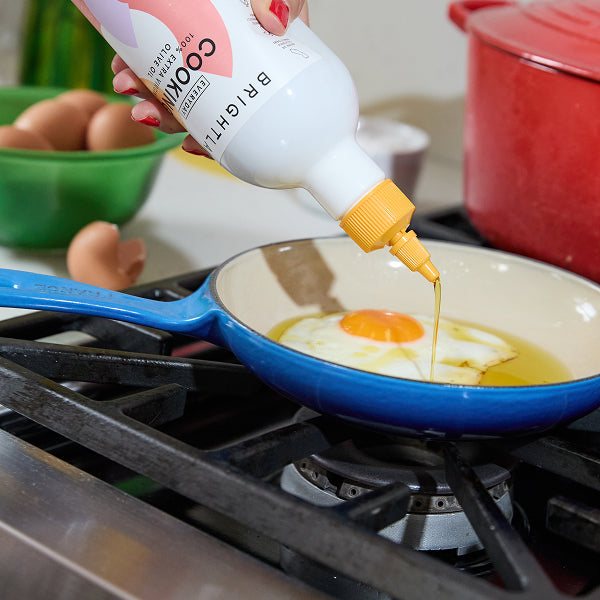[open type="rte"]

You have almost certainly eaten honey at some point or another in your life — but have you ever stopped to ask yourself how honey is made? This extremely common natural sweetener is actually the result of a very complex process and a delicate balance maintained by flora and fauna (and helped along by beekeepers). Today, we are diving deep into how honey is made, covering the different roles that bees play, how they transfer nectar to the hive and how they turn nectar into honey. Then, we will look at how humans take the raw honeycombs and turn it into the honey that you probably have sitting on your pantry shelf right now.
[close type="rte"][open type="rte"]
How Honey Is Made: Different Types of Bees
There are several different types of bees, all of whom work together to keep the hive functional and produce the honey we know and love. The main types of bees are:
[close type="rte"][open type="rte"]

[close type="rte"][open type="rte"]
- Queen bee. This female bee is the only one in the hive capable of sexual reproduction. She mates with the male drones and then continuously lays eggs to keep the bee population of the hive steady. Queens may live for up to five years but are usually replaced every two to three years by the hive as they reach the end of their useful life.
- Worker bees. These female bees are not capable of sexual production and do the main work of the hive. They build honeycombs, forage for nectar and place it in the hive, produce royal jelly to feed the queen and her larvae, remove debris and dead bees from the hive, maintain the temperature of the hive and keep the queen warm during the winter. These bees live anywhere from five to six weeks (if they are born during the nectar harvesting season) to five to six months (if they are born in the fall and are needed to keep the queen alive during winter).
- Drone bees. These male honey bees have only one role: to fertilize a queen bee so she can produce viable eggs. They mate, eat, rest and that is pretty much it. They will be reared in the spring and summer mating season and then will be forced out of the hive in the late fall in order to save the food resources for the productive worker bees, who are needed to keep the queen alive.
[close type="rte"][open type="rte"]
How Honey Is Made: From Flower to Hive
Honey is made as part of the essential pollinating process. While some plants rely on the wind to spread pollen from one flower to another, others rely on animals, such as bees and moths, to transfer the pollen for them.
Bees are great pollinators because their bodies are furry and the pollen sticks to their fur and then rubs off when they visit another flower. They also enjoy pollen because they eat it for protein. Bees will use their front legs, which are covered in little combs, to remove the pollen from their body fur and stick it to their back legs and then carry it back to the hive.
[close type="rte"][open type="images" count="1"]

[close type="images"][open type="rte"]
Bees are attracted to flowers because of the nectar, which is basically tasty sugar water. The different types of flowers and their unique pollens are what contribute to the taste and smell of the honey. Each individual bee is flower monogamous, meaning that they will only return to one type of plant for their entire lives. However, different bees in the same hive may “imprint” on different types of flowers, which is how you end up with wildflower honey sourced from multiple types of flowers.
As the name suggests, single flower honeys come from the nectar of only one type of flower, which means that the taste of that one plant really shines through. On the other hand, multi-flower honeys — usually called wildflower honeys — incorporate nectars from different plants and thus have a more complex flavor. Single flower honey is not necessarily better, it just has a different flavor and smell profile! Beekeepers may plant certain flowers around the hive depending on what type of honey they are trying to get.
The bees siphon up the nectar and store it in their honey stomach, a special organ that they use to carry the honey back to the hive. Once the bee is full of nectar and loaded down with pollen, she flies back to the hive to deposit her riches. Back at the hive, the forager bee is met by processor bees and hands off her honey to them. This allows the forager to fly right back out to siphon up more nectar from flowers.
[close type="rte"][open type="rte"]
How Honey Is Made: From Nectar to Honey
While the forager bee goes back for more, these processor bees take the honey and mix it with an enzyme called invertase. Then, they fly all the way to the top of the hive and regurgitate the mixture into a honeycomb. The invertase is responsible for converting the nectar’s sucrose into fructose and glucose, which form the building blocks of honey. They do this because bees can not digest sucrose and other complex polysaccharides.
Nectar is very liquid, so the bees fan it with their wings to help some of the water evaporate. Once the moisture content falls below 18 percent, the nectar has become honey and the bees seal the honeycomb with a wax cap to preserve it through the winter. This honey is so resistant to spoilage that it will keep for basically forever as long as it is left untouched. Once the honeycomb has been capped with wax, it is officially ready to harvest, which we will cover in the next section.
Beekeepers keep a close eye on their bee colonies to make sure that they are healthy and not producing too much or too little honey. If the colony seems ready to produce more honey, the beekeeper may add additional structures so the bees will have room to spread out and will not be tempted to swarm. If they think that the colony does not have enough honey to make it through the winter, they will supplement the hive with sugar so the bees do not starve.
[close type="rte"][open type="rte"]

[close type="rte"][open type="rte"]
How Honey Is Made: Harvesting the Honey
Between late summer and early autumn, beekeepers harvest honey one to three times, depending on how productive the hive has been. An average hive needs about 100 lbs. of honey to survive the winter, but most make two or even three times that, which allows us to reap the benefits by harvesting the extra honey. In order to remove the honeycombs, the bees must first be removed. There are three ways to accomplish this:
- The beekeeper brushes the bees off the honeycomb manually (while wearing protective gear, of course).
- The beekeeper puffs smoke into the hive using honeycombs. The bees think the smoke signals fire and suck up as much honey as they can before they flee. Being full of honey makes them calmer and less likely to sting.
- The beekeeper separates the queen bee from the hive using a separator board. When the worker bees realize the queen is missing, they exit the hive through a one-way slot that keeps them from coming back inside.
Once the honeycombs have been removed from the hive and transported away from bees, the beekeeper removes the wax caps using a long-handled uncapping fork to release the honey. Then, the honeycombs are placed in a device called an extractor, which is basically a big upright cylinder with a spigot at the bottom. The honeycombs are spun inside the centrifuge until the centrifugal force extracts the honey.
[close type="rte"][open type="images" count="1"]

[close type="images"][open type="rte"]
The liquid honey drips through the spigot at the bottom into a honey bucket. The bucket usually has two filters, a larger coarse one and a finer soft one. These filters remove any chunks of honeycomb that have broken off during the harvesting as well as any other solid debris that may have gotten into the honey.
Now you have raw honey, which is ready to be consumed and also has the highest level of pollen possible (meaning that it will have the most flavor and nutritious benefits). At this point, our Brightland raw honeys are ready to be packaged in honey jars and prepared to ship to consumers. However, some large honey manufacturers put the honey through additional processing steps, which we will cover in the following section.
[close type="rte"][open type="rte"]
How Honey Is Made: Additional Processing
There are several different types of processing that honey may go through. One step is additional filtration, which removes air bubbles and gives the honey a more uniform, transparent look that is considered aesthetically pleasing. Less reputable producers may put their honey through ultrafiltration in order to remove all pollen and make the origin of the honey untraceable. Some people who may be more accustomed to seeing filtered or ultrafiltered honey on store shelves are put off by the sometimes cloudy appearance of raw honey, which is due to the higher pollen content.
Honey may also be heated in several different ways in order to pasteurize it, either by holding it at a moderate temperature for 24 hours or by rapidly heating it to a higher temperature for a few minutes and then cooling it down immediately. Pasteurization is usually done to remove potentially harmful bacteria from dairy products and other foods, but since honey contains no bacteria, it is actually pasteurized in order to remove yeast that may cause fermentation. This fermentation is not dangerous but it can make the honey cloudy over time, so pasteurizing the honey slows down the crystallization process and also contributes to an aesthetically pleasing honey.
[close type="rte"][open type="rte"]

[close type="rte"][open type="rte"]
Unfortunately, this heating process also destroys much of the pollen in the honey, and thus removes much of the flavor and the nutritional benefits. The detrimental effects of heat on honey is one of the reasons why we do not ever heat our Brightland honeys above the natural temperature of the hive, and also recommend storing honey in a cool dry place away from ovens and sunny windows. Learn more about what raw honey is.
Besides ultra-filtering and heating the honey, some large commercial operations actually cut the honey with corn syrup or other cheaper sweeteners. This makes the product stretch farther and also increases profits for the company. Unfortunately, this means that the bear-shaped bottle full of super clear “honey” might not be 100 percent honey, or even honey at all — it could be a different type of syrup entirely. It might be cheap, but you usually get what you pay for when it comes to honey.
If you prefer the idea of high quality raw honey, then consider our raw honey set, The Couplet. It contains two honeys, a single flower California Orange Blossom honey and a multi-flower Kauai Wildflower honey, for a variety of flavors to suit all palates. We never heat our honey and package it as close to the hive as possible so you are getting the highest pollen count. We also work closely with small family-owned apiaries to ensure that the health of the bee colonies is never jeopardized during the honey production process. Taste the difference and order our raw honey set today!
Image Credits
COOL.ICE.BEAR/Shutterstock.com
Artem Novosad/Shutterstock.com
[close type="rte"]


























